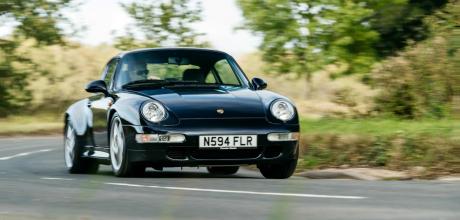1996 Porsche 911 Carrera 4S 993
The 993 Carrera 4S is one of the last air-cooled 911s. 25 years on, we drive one of the best of its kind. Written by Ben Barry. Photography by Ali Cusick.
LAST OF THE AIR-COOLED
Widebodied 993 C4S road test 993 C4S: last of the air-cooled era. It was the last 911 of the air-cooled era: what’s it like to drive today?
There’s no shortage of milestones throughout the long history of Porsche road cars, but if I were pushed to pick one pivotal year it would have to be 1996. That was the year a quarter of a century ago that Porsche transitioned from the past to the future, securing its survival and laying the foundations for today’s success.
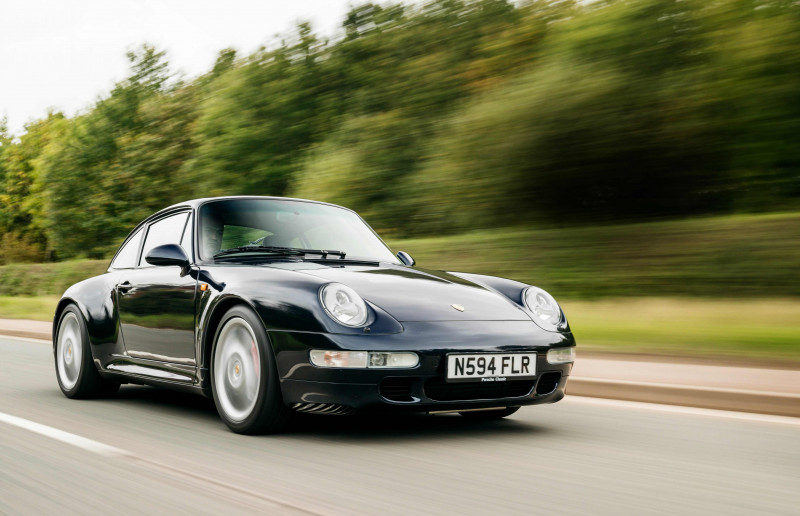
In the fallow years prior, Porsche sales had withered to just 12,500 units at the time of the 993-era 911’s introduction in 1993. In the success that followed, the new Boxster was joined by a radically redesigned water-cooled 911 and, later, the Cayenne SUV. But for a brief period from 1996 (and yes, a short while after), past and future co-existed in the shape of new sports cars that represented the start and the end of their respective eras – the all-new Boxster effectively blooding the 911’s water-cooled future, and the new 993 Carrera 4S arriving as a run-out special to mark the beginning of the end of the air-cooled 911 era.
“The wide body, wider tyres and extra driven wheels build on the 911’s excellent traction to make a C4S awesomely competent”
As much as the new era saved Porsche and deserves to be celebrated, the air-cooled 911s of that period are more venerated and valuable today, so when Avantgarde Classics invited us to drive a beautiful low-mileage C4S that had just arrived in stock, late 2021 seemed a great opportunity to revisit the sought-after model on some challenging roads close to its Tamworth base.
Boss Jonathan Aucott rolls up to meet us with the flat six purring gently away, and already I’m smitten – gorgeous deep Midnight blue paint highlights the 993’s understated curves, with this transitional generation’s more laid-back polyellipsoid headlights and rakish windscreen emphasising the lack of cylinders under its low-set bonnet, while wide hips and a full-width light bar wrap round the flat six with a dodgem-like chunkiness. The design’s beautifully set off by the 18-inch ‘twist’ alloys, factory lowered suspension and the red brake calipers gripping drilled discs.
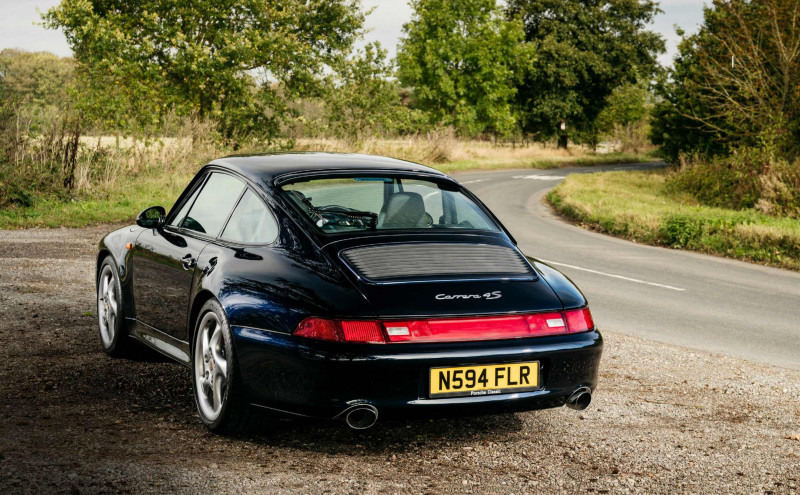
This 993 looks stunning partly because Jonathan’s given it an extensive deep clean, which extends to, as he puts it, “taking the wheels off, getting the toothbrushes out, removing any dirt underneath and generally just going a bit mad.” But it’s also because the mileometer reads a genuine 24,000 miles. The documentation reveals this is a C16-spec car, meaning it was supplied new to the UK, in this case to a London property company, and first registered on 1 March 1996 – the C4S even comes with its original V5 ownership documents.
Jonathan attributes the extremely low mileage to the car having been stored in an underground car park for a period, after which it was recommissioned by Porsche and registered on the Porsche Classic Register on 6 Sept 2018. All routine servicing has been undertaken by Official Porsche Centres, all of it backed up with invoices, with a specialist used for maintenance, including a geometry check and new clutch more recently.
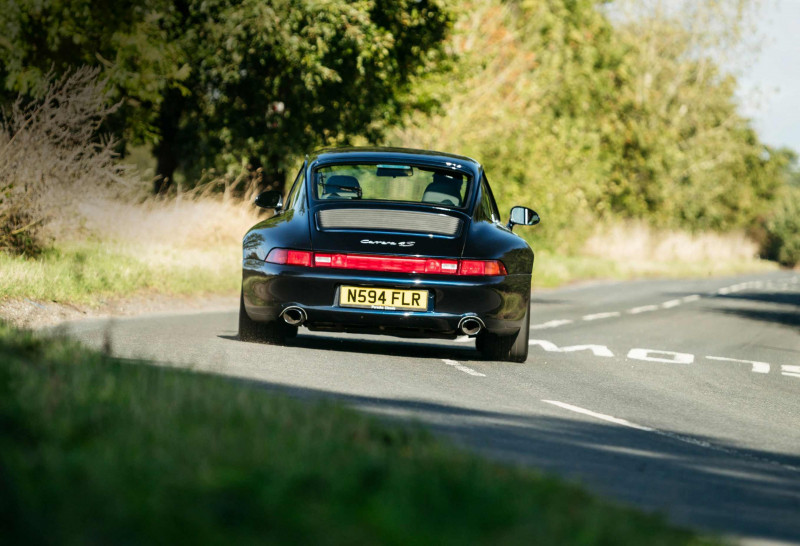
So this is one of the finest examples of arguably the ultimate all-wheel-drive, air-cooled Carrera, and whatever your view, the C4S is certainly the last. But the story of all-wheel-drive 911s really dates back to engineers Helmuth Bott and Peter Falk testing an Audi Quattro road car – as developed by former Porsche engineer Jörg Bensinger – at the Monte Carlo rally in January 1981 before deciding to build an all-weather 911 on the journey home.
The engineering team didn’t mess about, and by the winter of 1981-1982 a prototype was already testing over the fast and flowing Turracher Höhe Pass in Austria, and Porsche had already displayed the snappily named 911 Turbo 3.3 4x4 Cabriolet at the 1981 Frankfurt show. Motorsport played a crucial role too, when Jacky Ickx won the Paris-Dakar in 1984 in an all-wheel-drive Carrera, the first sports car to do so, and then came the 959 supercar – essentially an all-wheel-drive über 911, Porsche’s first all-wheel-drive road car and another Paris-Dakar winner. This all laid the groundwork for Porsche to launch an all-wheel-drive 911 and it did so not by adding a variant to an existing range, but by introducing the new 964 as a Carrera 4 first, only adding the more traditional rear-drive Carrera 2 model later.
The 964 wasn’t perfect, though, and somewhat prone to understeer with its fixed 69:31 torque split; when the 993 arrived in 1993, it swapped the 964’s mechanical centre diff packaged in the gearbox housing for a viscous coupling, for an infinitely variable torque split and more finesse. The switch also reduced mechanical losses by 50 per cent, and the weight increase over a Carrera 2 fell from 100kg to just 50kg. Finally, a more compact and simplified front differential allowed the 4 to offer the same 123 litres of boot space as a 2.
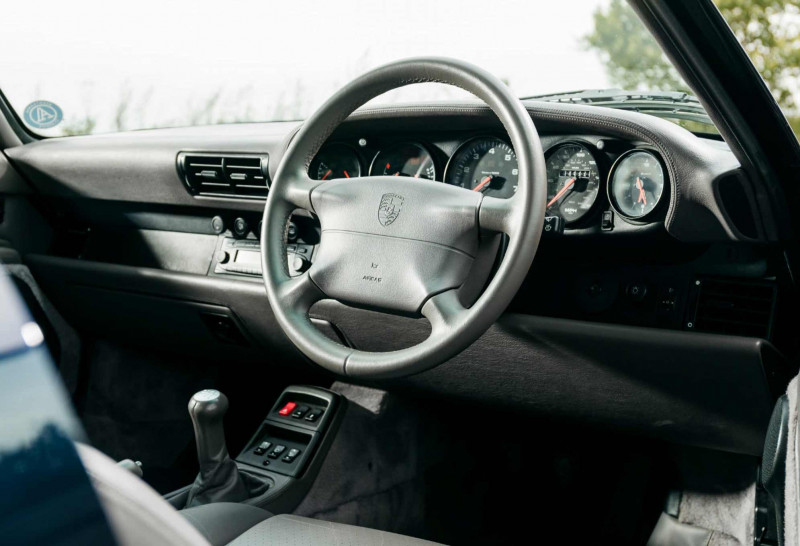
In those days, Carrera 4s retained identical narrow bodies to Carrera 2s, but when Porsche launched the 993 Turbo, it was notable both for being the first Turbo with all-wheel drive, and easy to spot courtesy of its unique bumpers. When the C4S arrived in 1996, it essentially combined the Turbo and Carrera 4 into one highly specified package. The C4S got the 30mm wider arches (but a rear wing that automatically extended at speed, not the Turbo’s huge rear decklid – there was, after all, no intercooler sitting over the engine for it to cover), suspension lowered 10mm at the front, 20mm at the rear like the Turbo, plus 18-inch Turbo-look ‘Twist’ alloys and brakes lifted straight from the Turbo too, with drilled discs measuring 322mm up front, 299mm at the rear.
Inevitably pricing did increase, however, to a pretty punchy £74,795, some £12,300 pricier than a Carrera 4, if still some way off the Turbo at £93,950. In total, 6,948 examples of the Carrera 4S were produced from 1996, all of them Coupes, which perhaps surprisingly makes them more numerous than the Carrera 4, of which 4,700 were produced. But if you want the steering wheel on the correct side, this gorgeous C4S is one of only 181 right-hand-drive examples produced.
I’ve never driven an all-wheel-drive 993, so I open the door, lower down into the leather seats and pull the door behind me, intrigued to discover how it feels – it’s a sober kind of luxury in here, a monotone of classic grey leather and carpet, minimal switchgear, with top billing given to the five dials that fan out in the instrument binnacle.
Like all C4S models, this one was highly specified from the factory, with Porsche’s Full Leather swathing the dashboard, gearknob, steering wheel, door casings and of course the seats. There’s a trip computer, air-con (normally a £2,375 option!), and while Sports seats were available, this one’s got the comfort-spec chairs, electrically adjustable eight ways – they still hold you nicely in place without making stouter types feel constricted, and the grey leather also has a lovely, just-bedded-in look, especially the bolsters.
More than anything it’s the quality of construction that strikes you, from the feel of what plastics remain on display to the click of the switchgear, even the tight pop of the door latching, which sounds simultaneously precision engineered and light at the same time.
Twist the key and the 3.6-litre flat six wakes with the trademark breathy chunter. The C4S’s floorhinged clutch is a big press down and purposefully weighted, and the hydraulically assisted steering has a similarly meaty feel as I ease out of the car park. It feels like it’d be easy to stall if you gave it too much lock and not enough throttle (reader, I didn’t), but the weight melts away given just a little speed, replaced by feel, delicacy and an impressively supple ride.
The C4S runs 225/40 ZR18 front and 285/30 ZR18 rear tyres and its suspension lowered 10mm at the front, 20mm at the rear, but the rates were actually softened a little for the C4S. It’s certainly perfectly at home over a British B-road, with all the best bits of the surface information filtering through to the steering and all the nasty stuff slipping to the background. Perhaps surprisingly given the market these days and the fact that PDK and Carrera 4 are essentially synonymous, every 993 C4S has a manual gearbox, but it’s a lovely positive shift with a purposefully slick heft.
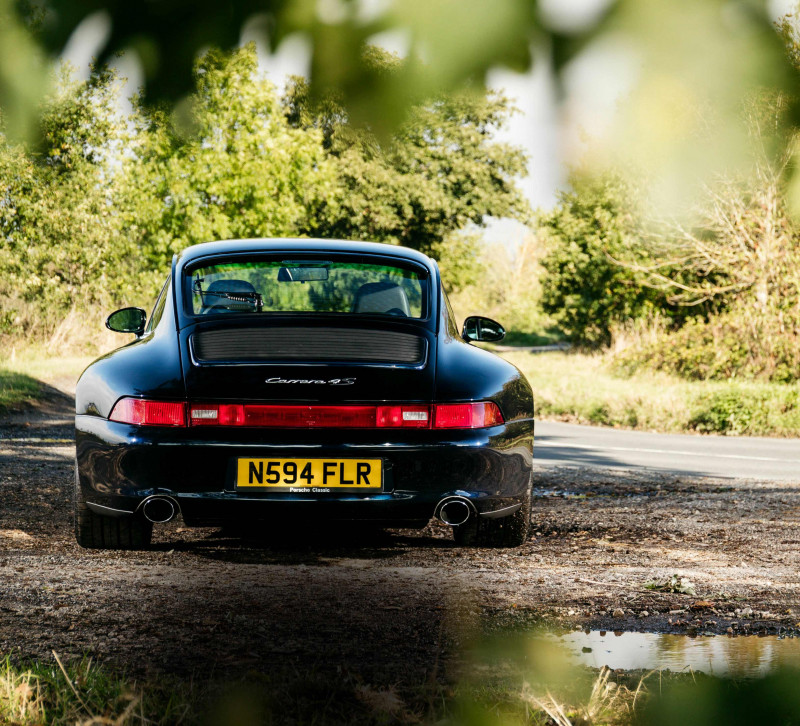
A C4S will trundle about happily, then, but it also knows how to pick up its heels and run for the horizon, even if this first of the ‘modern’ S models didn’t actually offer an increase in performance. Instead the M64 3.6-litre flat six produces the same 285bhp and 340Nm as all other Carreras fitted with the new VarioRam system from 1996, up from the previous 272bhp and 330Nm respectively.
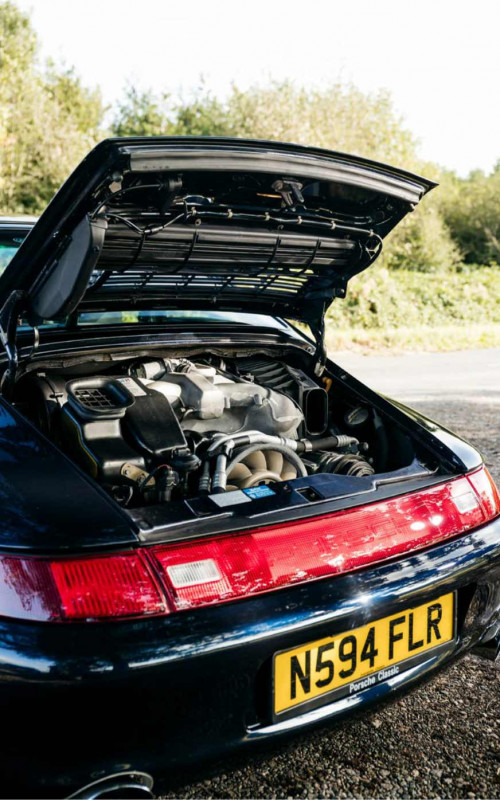
It’s nice and tractable from low revs, pulling smoothly and stoutly if with little in the way of drama or real stand-out performance, but if you stir the cogs or just patiently sit it out, the real action starts from 4,000rpm – it’s a smooth transition to a significantly higher level of performance, but there’s unmistakable extra urge and energy as its rasps right round to 6,800rpm, the noise perhaps a little subdued in the car, the sound of the twin exhaust pipes more exuberant outside. Yes, a Turbo is significantly quicker both objectively when you wring its 408bhp and subjectively when you’re cruising because it serves up its more generous torque more easily, but there’s decent performance here and I prefer the naturally aspirated character and delivery to the less tuneful, more abrupt Turbo, much as there’s appeal in that too.
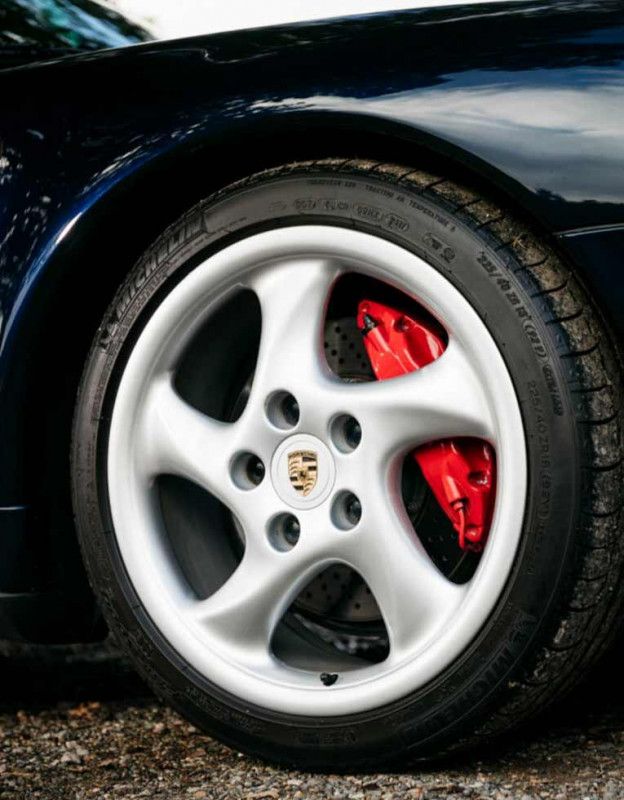
No surprise that Turbo-spec brakes are more than a match for the more moderate levels of performance than they’re engineered to contain, with a pedal that bites immediately, feels quite ‘full’ like you’re stepping on a balloon and, if I’m nitpicking, would benefit from a little more progression.
Work the chassis harder, turn in to a tighter corner and, while the steering has plenty of feel, it does lose a little of a Carrera 2’s incisiveness around the straight ahead – together with the light nose and the all-wheel drive, there’s an initial floatiness as you turn in and an early warning of understeer if you keep accelerating. You still need to play with the weight distribution and the momentum to get the best from the C4S, so give the throttle a little lift and the nose tucks in, the tail subtly shifts round by a few degrees and you can climb back on the throttle and ping down the road like someone’s released an elastic band. The C4S uses a combination of good ol’ limited slip diff in its multi-link LSA rear axle with new-fangled braking via the ABS called ABD (for Automatic Brake Differential, which was standard from the Carrera 4 up), which applies a little braking force to the inside wheel if it senses slip. Add everything together and it really does hook that rear end up, which could either be described as unflappably secure or overkill, depending on your viewpoint.
But there’s still involvement here because all-wheel drive can’t cast aside a 911’s tail-heavy physics, you can’t just boot the throttle before the apex – there’s still that float – but the wide body, wider tyres and extra driven wheels build on the 911’s excellent traction to make a C4S awesomely competent. By the time I hand the keys back to Jonathan I’m already dreaming of a trip to the Austrian Alps where the AWD Carrera was first tested. Find yourself £134,950 and you can make that a reality.
THANKS The stunning car in our pictures is for sale at Avantgarde Classics. For more information call +44 (0) 1827 288177
The 993 Carrera 2S
Porsche had one more air-cooled Carrera up its sleeve before the end of production: the Carrera 2S, which was introduced in 1997. It married the wider Turbo body with the 2’s rear-wheel-drive chassis and 3.6-litre naturally aspirated engine. Like the 4S, its suspension was lowered, but the standard 17-inch wheels were an inch smaller, and it didn’t get the Turbo-spec brakes. Other than the 2S badge on the rump, the air inlet over the engine is split into two halves, like butterfly wings. It was also offered with both the four-speed Tiptronic automatic gearbox and the six-speed manual. In total, 3,700 examples of the Carrera 2S were produced.
LEFT The 993 C4S has an enviable spec including a widebody, VarioRam flat six and Turbo chassis.
TECHNICAL DATA1996 Porsche 911 Carrera 4S 993
- Model 993 C4S
- Year 1996
Engine
- Capacity 3,600cc
- Compression ratio 11.3:1
- Maximum power 285bhp @ 6,100rpm
- Maximum torque 340Nm @ 5,250rpm
- Transmission Six-speed manual
Suspension
- Front MacPherson strut
- Rear Multi-link
Wheels & tyres
- Front 8x18-inch, 225/40 ZR18
- Rear 10x18-inch, 285/30 ZR18
Dimensions
- Length 4,245mm
- Width 1,795mm
- Weight 1,520kg
Performance
- 0-62mph 5.3sec
- Top speed 168mph
ABOVE The C4S has a standard Carrera interior, though many are generously optioned


